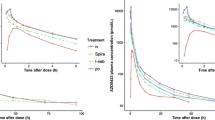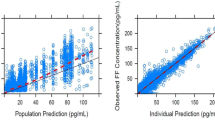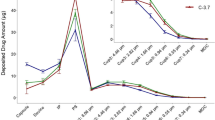Abstract
Objective: To evaluate the pharmacokinetic and systemic pharmacodynamic properties of inhaled fluticasone propionate (FP).
Methods: Single doses of 0.25, 0.5, 1.0 and 3.0 mg FP were administered to groups of six healthy subjects. Serum concentration profiles of FP were monitored over 24 h by means of high-performance liquid chromatography/mass spectrometry (HPLC/MS–MS). Systemic pharmacodynamic effects were evaluated by measuring endogenous serum cortisol and circulating white blood cells, and analyzed with previously developed integrated pharmacokinetic/pharmacodynamic (PK/PD) models.
Results: FP showed a dose-independent terminal half-life with a mean (SD) of 6.0 (0.7) h. Maximum serum concentrations occurred 1.0 (0.5) h after administration, ranging from 90 pg · ml−1 for the 0.25 mg dose to 400 pg · ml−1 for the 3.0 mg dose. This, together with an estimated mean absorption time of nearly 5 h and a known oral bioavailability of less than 1%, indicates prolonged residence at and slow absorption from the lungs. In the investigated dose range, the cumulative systemic effect was dose-dependent for both markers of pharmacodynamic activity. For doses of 0.25, 0.50, 1.0 and 3.0 mg FP, the PK/PD-based cumulative systemic-effect parameters were 159, 186, 257 and 372% · h for lymphocyte suppression, 107, 186, 202 and 348% · h for granulocyte induction and 23.6%, 33.8%, 51.0% and 73.6% for cortisol reduction, respectively. The time courses of lymphocytes, granulocytes and endogenous cortisol could be sufficiently characterized with the applied PK/PD models. The measured in vivo EC50 values, 30 pg · ml−1 and 7.3 pg · ml−1 for white blood cells and cortisol, respectively, were in good agreement with predictions based on the in vitro relative receptor affinity of FP.
Conclusion: After inhalation, FP follows linear pharmacokinetics and exhibits dose-dependent systemic pharmacodynamic effects that can be described by PK/PD modeling.
Similar content being viewed by others
Author information
Authors and Affiliations
Additional information
Received: 27 January 1997 / Accepted in revised form: 5 August 1997
Rights and permissions
About this article
Cite this article
Möllmann, H., Wagner, M., Meibohm, B. et al. Pharmacokinetic and pharmacodynamic evaluation of fluticasone propionate after inhaled administration. E J Clin Pharmacol 53, 459–467 (1998). https://doi.org/10.1007/s002280050407
Issue Date:
DOI: https://doi.org/10.1007/s002280050407




